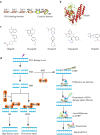Advances and perspectives of PARP inhibitors
- PMID: 31737426
- PMCID: PMC6849303
- DOI: 10.1186/s40164-019-0154-9
Advances and perspectives of PARP inhibitors
Abstract
DNA damage repair deficiency leads to the increased risk of genome instability and oncogenic transformation. In the meanwhile, this deficiency could be exploited for cancer treatment by inducing excessive genome instability and catastrophic DNA damage. Continuous DNA replication in cancer cells leads to higher demand of DNA repair components. Due to the oncogenic loss of some DNA repair effectors (e.g. BRCA) and incomplete DNA repair repertoire, some cancer cells are addicted to certain DNA repair pathways such as Poly (ADP-ribose) polymerase (PARP)-related single-strand break repair pathway. The interaction between BRCA and PARP is a form of synthetic lethal effect which means the simultaneously functional loss of two genes lead to cell death, while defect in any single gene has a slight effect on cell viability. Based on synthetic lethal theory, Poly (ADP-ribose) polymerase inhibitor (PARPi) was developed aiming to selectively target cancer cells harboring BRCA1/2 mutations. Recently, a growing body of evidence indicated that a broader population of patients could benefit from PARPi therapy far beyond those with germline BRCA1/2 mutated tumors. Numerous biomarkers including homologous recombination deficiency and high level of replication pressure also herald high sensitivity to PARPi treatment. Besides, a series of studies indicated that PARPi-involved combination therapy such as PARPi with additional chemotherapy therapy, immune checkpoint inhibitor, as well as targeted agent had a great advantage in overcoming PARPi resistance and enhancing PARPi efficacy. In this review, we summarized the advances of PARPi in clinical application. Besides, we highlighted multiple promising PARPi-based combination strategies in preclinical and clinical studies.
Keywords: Combination therapy; DNA repair; Immune checkpoint inhibitor; PARPi; Synthetic lethal.
© The Author(s) 2019.
Conflict of interest statement
Competing interestsThe authors declare that they have no competing interests.
Figures

References
Publication types
LinkOut - more resources
Full Text Sources
Miscellaneous

